Kenmore 79579432216, 79579432217, 79579432218, 79579433216, 79579433217 Owner’s Manual
...
Use & Care Guide
Manual de Uso y Cuidado
English / Español
Models/Modelos: 795.7940*, 795.7943*
Kenmore®
Top Mount Refrigerator
Congelador Superior Refrigerador
* = color number, número de color
P/N MFL67527901-4
Sears Brands Management Corporation
Ho man Estates, IL 60179 U.S.A.
www.kenmore.com
®

TABLE OF CONTENTS
Warranty............................................................................. |
3 |
Protection Agreements............................................... |
4 |
Important Safety Instructions............................ |
5-7 |
Electrical & Grounding Requirements............... |
7 |
Parts and Features........................................................ |
8 |
Refrigerator Installation.............................. |
9-19 |
Unpacking Your Refrigerator.......................... |
9 |
Installation..................................................................... |
10 |
Removing and Replacing the Doors........ |
11-12 |
Reversing the Doors................................... |
13-19 |
Leveling............................................................ |
19 |
Door Alignment............................................... |
19 |
Using Your Refrigerator............................ |
20-24 |
Setting the Controls....................................... |
20 |
Food Storage Guide...................................... |
21 |
Water Dispenser........................................... |
22 |
Automatic Icemaker ..................................... |
22 |
Refrigerator Shelves................................................. |
23 |
Pantry Drawer................................................ |
23 |
Humidity Controlled Crisper........................ |
24 |
Door Bins ........................................................... |
24 |
Dairy Bin......................................................... |
24 |
Water Filter................................................. |
25-26 |
Care and Cleaning.................................... |
27-28 |
Connecting the Water Line........................ |
29-31 |
Troubleshooting Guide............................. |
32-37 |
Service................................................ |
Back Cover |
2

WARRANTY
REFRIGERATOR WARRANTY
®
Kenmore Limited Warranty
FOR ONE YEAR from the date of sale this appliance is warranted against defects in material or workmanship when it is correctly installed, operated and maintained according to all supplied instructions.
WITH PROOF OF SALE, a defective appliance will receive free repair or replacement at option of seller.
For warranty coverage details to obtain free repair or replacement, visit the web page: www.kenmore.com/warranty This warranty applies for only 90 DAYS from the sale date in the United States, and is void in Canada, if this appliance is ever used for other than private household purposes.
This warranty covers ONLY defects in material and workmanship, and will NOT pay for:
1.Expendable items that can wear out from normal use, including but not limited to filters, belts, bags or screw-in base light bulbs.
2.A service technician to clean or maintain this appliance, or to instruct the user in correct appliance installation, operation and maintenance.
3.Service calls to correct appliance installation not performed by Sears authorized service agents, or to repair problems with house fuses, circuit breakers, house wiring, and plumbing or gas supply systems resulting from such installation.
4.Damage to or failure of this appliance resulting from installation not performed by Sears authorized service agents, including installation that was not in accord with electrical, gas or plumbing codes.
5.Damage to or failure of this appliance, including discoloration or surface rust, if it is not correctly operated and maintained according to all supplied instructions.
6.Damage to or failure of this appliance, including discoloration or surface rust, resulting from accident, alteration, abuse, misuse or use for other than its intended purpose.
7.Damage to or failure of this appliance, including discoloration or surface rust, caused by the use of detergents, cleaners, chemicals or utensils other than those recommended in all instructions supplied with the product.
8.Damage to or failure of parts or systems resulting from unauthorized modifications made to this appliance.
9.Service to an appliance if the model and serial plate is missing, altered, or cannot easily be determined to have the appropriate certification logo.
Disclaimer of implied warranties; limitation of remedies
Customer’s sole and exclusive remedy under this limited warranty shall be product repair or replacement as provided herein. Implied warranties, including warranties of merchantability or fitness for a particular purpose, are limited to one year or the shortest period allowed by law. Seller shall not be liable for incidental or consequential damages. Some states and provinces do not allow the exclusion or limitation of incidental or consequential damages, or limitation on the duration of implied warranties of merchantability or fitness, so these exclusions or limitations may not apply to you.
This warranty applies only while this appliance is used in the United States or Canada*.
This warranty gives you specific legal rights, and you may also have other rights which vary from state to state.
* In-home repair service is not available in all Canadian geographical areas, nor will this warranty cover user or servicer travel and transportation expenses if this product is located in a remote area (as defined by Sears Canada Inc.) where an authorized servicer is not available.
Sears Brands Management Corporation, Ho man Estates, IL 60179
Sears Canada Inc., Toronto, Ontario, Canada M5B 2C3
3
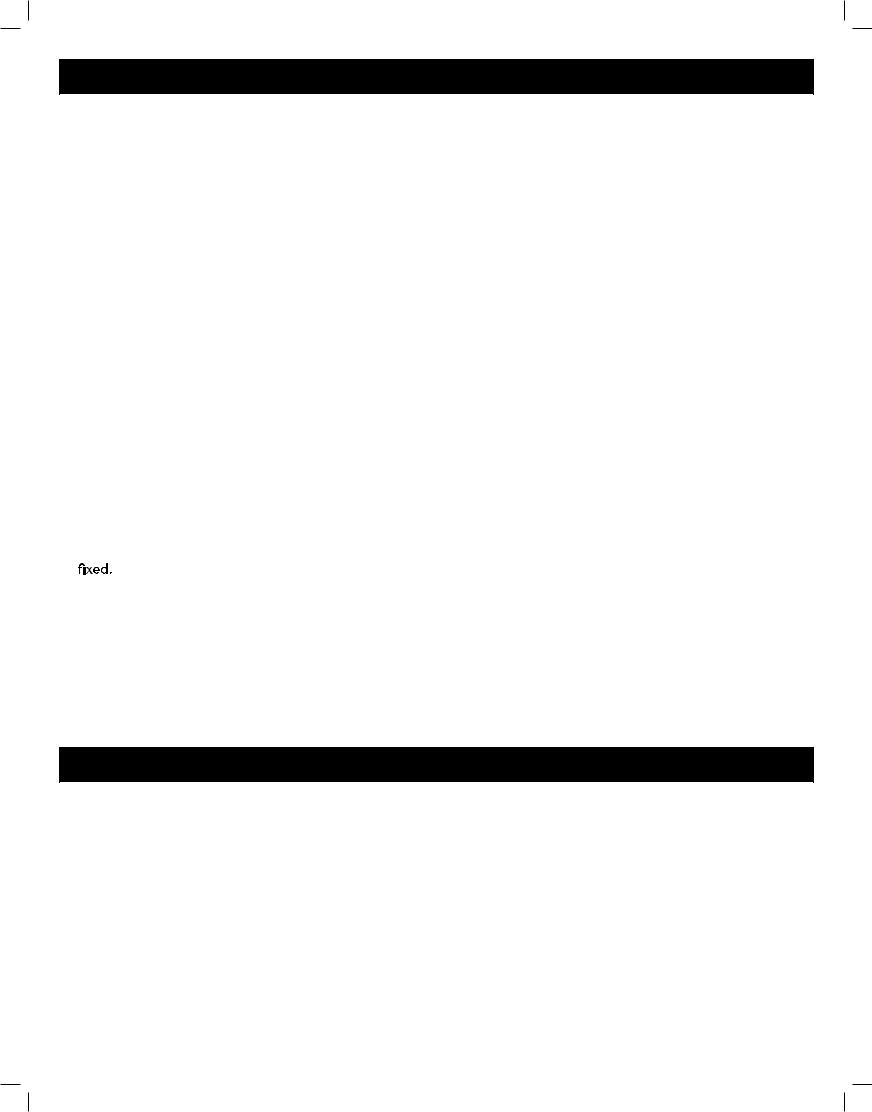
PROTECTION AGREEMENTS
Master Protection Agreements
Congratulations on making a smart purchase. Your new Kenmore® product is designed and manufactured for years of dependable operation. But like all products,
it may require preventive maintenance or repair from time to time. That’s when having a Master Protection Agreement can save you money and aggravation.
The Master Protection Agreement also helps extend the life of your new product. Here’s what the Agreement* includes:
•Parts and labor needed to help keep products operating properly under normal use, not just defects. Our coverage goes well beyond the product warranty.
No deductibles, no functional failure excluded from coverage— real protection.
•Expert service by a force of more than 10,000 authorized Sears service technicians, which means someone you can trust will be working on your product.
•Unlimited service calls and nationwide service, as often as you want us, whenever you want us.
•“No-lemon” guarantee – replacement of your covered product if four or more product failures occur within twelve months.
•Product replacement if your covered product can’t be
•Annual Preventive Maintenance Check at your request
–no extra charge.
•Fast help by phone – we call it Rapid Resolution
–phone support from a Sears representative on all products. Think of us as a “talking owner’s manual.”
•Power surge protection against electrical damage due to power 
•$250 Food Loss Protection annually for any food spoilage that is the result of mechanical failure of any covered refrigerator or freezer.
•Rental reimbursement if repair of your covered product takes longer than promised.
•10% discount  the regular price of any non-covered repair service and related installed parts.
the regular price of any non-covered repair service and related installed parts.
Once you purchase the Agreement, a simple phone call is all that it takes to schedule service. You can call at any time day or night, or schedule a service appointment online.
The Master Protection Agreement is a risk free purchase. If you cancel for any reason during the product warranty period, we will provide a full refund or a prorated refund anytime after the product warranty period expires.
Purchase your Master Protection Agreement today!
Some limitations and exclusions apply.
For prices and additional information in the U.S.A. call 1-800-827-6655.
* Coverage in Canada varies on some items. For full details call Sears Canada at 1-800-361-6665.
Sears Installation Service
For Sears professional installation of home appliances, garage door openers, water heaters, and other major home items, in the U.S.A. call 1-844-553-6667 and in
Canada call 1-800-469-4663.
PRODUCT RECORD
In the space below, record the date of purchase, model and serial number of your product. You will  the model and serial number printed on an
the model and serial number printed on an  label located on the interior liner of the refrigerator compartment. Have these items of information available whenever you contact Sears concerning your product.
label located on the interior liner of the refrigerator compartment. Have these items of information available whenever you contact Sears concerning your product.
Model No.___________________ |
Date of Purchase ___________________ |
Serial No.___________________ |
|
Save these instructions and attach your sales receipt for future reference.
4

IMPORTANT SAFETY INSTRUCTIONS
BASIC SAFETY PRECAUTIONS
This guide contains many important safety messages. Always read and obey all safety messages.
This is the safety alert symbol. It alerts you to safety messages that inform you of hazards that can kill or hurt you or others, or cause damage to the product.
All safety messages will be preceded by the safety alert symbol and the hazard signal word DANGER, WARNING or CAUTION. These words mean:
 DANGER
DANGER
 WARNING
WARNING
 CAUTION
CAUTION
You will be killed or seriously injured if you do not follow instructions.
You can be killed or seriously injured if you do not follow instructions.
Indicates an imminently hazardous situation which, if not avoided, may result in minor or moderate injury, or product damage.
All safety messages will identify the hazard, tell you how to reduce the chance of injury, and tell you what can happen if the instructions are not followed.
 WARNING
WARNING
To reduce the risk of fire, electric shock, or personal injury when using your product, basic safety precautions should be followed, including the following.
Read all instructions before using this appliance.
•NEVER unplug your refrigerator by pulling on the power cord. Always grip the plug firmly and pull it straight out from the outlet.
•Immediately repair or replace all power cords that have become frayed or otherwise damaged. Do not use a cord that shows cracks or abrasion damage along its length or at either the plug or connector end.
•Do not modify or extend the power cord length. It could cause electric shock or fire.
•When moving your refrigerator away from the wall, be careful not to roll over or damage the power cord.
•DO NOT store or use gasoline or other flammable vapors and liquids in the vicinity of this or any other appliance.
•DO NOT allow children to climb, stand, or hang on the refrigerator doors or shelves in the refrigerator. They could damage the refrigerator and seriously injure themselves.
•Keep fingers out of pinch point areas; clearances between the doors and cabinets are necessarily small. Be careful closing doors when children are in the area.
•Unplug your refrigerator before cleaning or making any repairs.
NOTE: It is strongly recommended that any service be performed by a qualified technician.
SAVE THESE INSTRUCTIONS
5
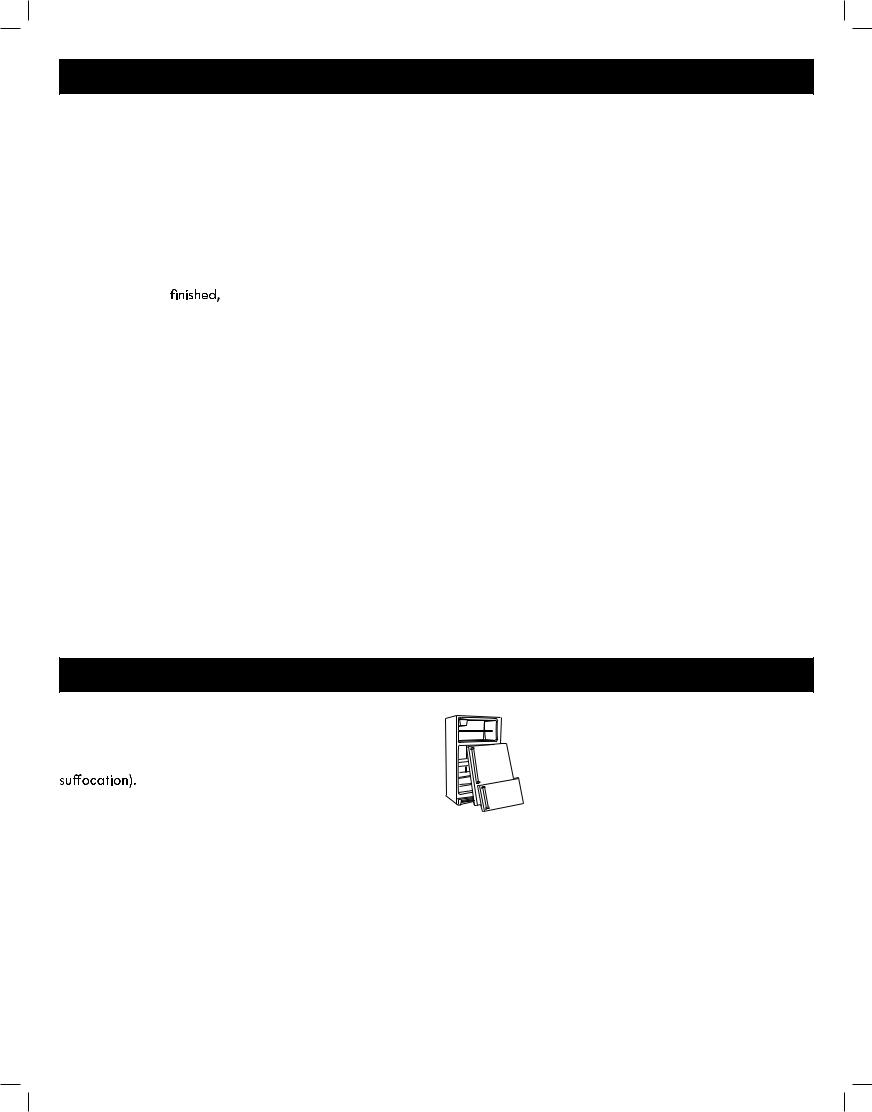
 WARNING
WARNING
•Before replacing a burned-out or broken light bulb,
unplug the refrigerator or turn  power at the circuit breaker or fuse box in order to avoid contact with a live
power at the circuit breaker or fuse box in order to avoid contact with a live
wire  (A burned-out light bulb may break when being replaced exposing the wire
(A burned-out light bulb may break when being replaced exposing the wire 
NOTE: Some models have LED interior lighting and service should be performed by a  technician.
technician.
 WARNING: Setting either or both controls to the OFF position does not remove power to the light circuit.
WARNING: Setting either or both controls to the OFF position does not remove power to the light circuit.
• When you are |
reconnect the refrigerator to |
the electrical source and reset the controls (Thermostat, Refrigerator Control, and or Freezer Control, depending on the model) to the desired setting.
•This refrigerator must be properly installed in accordance with the Attention Installer Instructions that were taped to the front of the refrigerator.
•After your refrigerator is in operation, do not touch the cold surfaces in the freezer compartment when hands are damp or wet. Skin may adhere to the extremely cold surfaces.
•DO NOT touch the automatic ice making mechanism while the refrigerator is plugged in.
•DO NOT refreeze frozen foods which have thawed completely. The United States Department of Agriculture in Home and Garden Bulletin No. 69 says:
…You may safely refreeze frozen foods that have thawed if they still contain ice crystals or if they are still cold—below 4°C.
…Thawed ground meats, poultry or  that have any
that have any  or
or  should not be refrozen and should not be eaten. Thawed ice cream should be discarded.
should not be refrozen and should not be eaten. Thawed ice cream should be discarded.
If the odor or color of any food is poor or questionable, dispose of it. The food may be dangerous to eat.
Even partial thawing and refreezing reduces the eating quality of foods, particularly fruits, vegetables and prepared foods. The eating quality of red meats
is  less than that of many other foods. Use refrozen foods as soon as possible to save as much of their quality as you can.
less than that of many other foods. Use refrozen foods as soon as possible to save as much of their quality as you can.
 WARNING: This product contains chemicals known to the State of California to cause cancer and birth defects or other reproductive harm. Wash hands after handling.
WARNING: This product contains chemicals known to the State of California to cause cancer and birth defects or other reproductive harm. Wash hands after handling.
SAVE THESE INSTRUCTIONS
 DANGER: RISK OF CHILD ENTRAPMENT
DANGER: RISK OF CHILD ENTRAPMENT
Junked or abandoned refrigerators are dangerous, even if they are sitting for only a few days. If you are getting rid of your old refrigerator, please follow the instructions at right to help prevent accidents (child entrapment and
BEFORE YOU THROW AWAY
YOUR OLD REFRIGERATOR
OR FREEZER:
•Take  the doors.
the doors.
•Leave the shelves in place so that children may not easily climb inside.
6

CFC DISPOSAL
Your old refrigerator may have a cooling system that used
CFCs (chlorofluorocarbons). CFCs are believed to harm stratospheric ozone.
If you are throwing away your old refrigerator, make sure the CFC refrigerant is removed for proper disposal by a qualified technician. If you intentionally release this CFC refrigerant, you may be subject to fines and imprisonment under provisions of environmental legislation.
ELECTRICAL & GROUNDING REQUIREMENTS
IMPORTANT: Please read carefully.
TO CONNECT ELECTRICITY
 WARNING
WARNING
Electrical Shock Hazard
FOR PERSONAL SAFETY, this appliance must be properly grounded. Have the wall outlet and the circuit checked by a qualified electrician to make sure the outlet is properly grounded.
3-prong grounding type wall receptacle
3-prong grounding plug
Ensure proper ground exists before use.
RECOMMENDED GROUNDING METHOD
The refrigerator should always be plugged into its own individual properly grounded electrical outlet rated for 115 Volts, 60 Hz, AC only, and fused at 15 or 20 amperes. This provides the best performance and also prevents overloading house wiring circuits which could cause a fire hazard from overheated wires. It is recommended that a separate circuit serving only this appliance be provided.
Use a receptacle that cannot be turned off with a switch or pull chain. Do not use an extension cord.
Where a standard two-prong wall outlet is encountered, it is your personal responsibility and obligation to have it replaced with a properly grounded three-prong wall outlet.
USE OF EXTENSION CORDS
Because of potential safety hazards under certain conditions, the use of an extension cord is not recommended. However, if you still elect to use an extension cord, it is absolutely necessary that it be a ULlisted (USA), 3-wire grounding type appliance extension cord having a grounding type plug and outlet, and that the electrical rating of the cord be 15 amperes (minimum) and 120 volts.
Use of an extension cord will increase the clearance needed for the back of the refrigerator.
7

PARTS AND FEATURES
L |
O |
Use this page to become more familiar with the parts and features of your refrigerator. Page references are included for your convenience.
NOTE: This guide covers several  models. The refrigerator you have purchased may have some or all of the items listed below. The locations of the features shown below may not match your model.
models. The refrigerator you have purchased may have some or all of the items listed below. The locations of the features shown below may not match your model.
A |
Custom Cube Icemaker* |
I |
Shelves |
B |
Ice Bin |
J |
Pantry Drawer |
C |
Freezer Shelf |
K |
Crispers |
D |
Freezer Temperature Control |
L |
Freezer Light (LED) |
E |
Refrigerator Temperature Control |
M |
Freezer Door Bins |
F |
Water Dispenser Button |
N |
Dairy Bin |
G |
Water Filter |
O Refrigerator Door Bins |
|
H |
Refrigerator Light (LED) |
|
|
* On some models
8
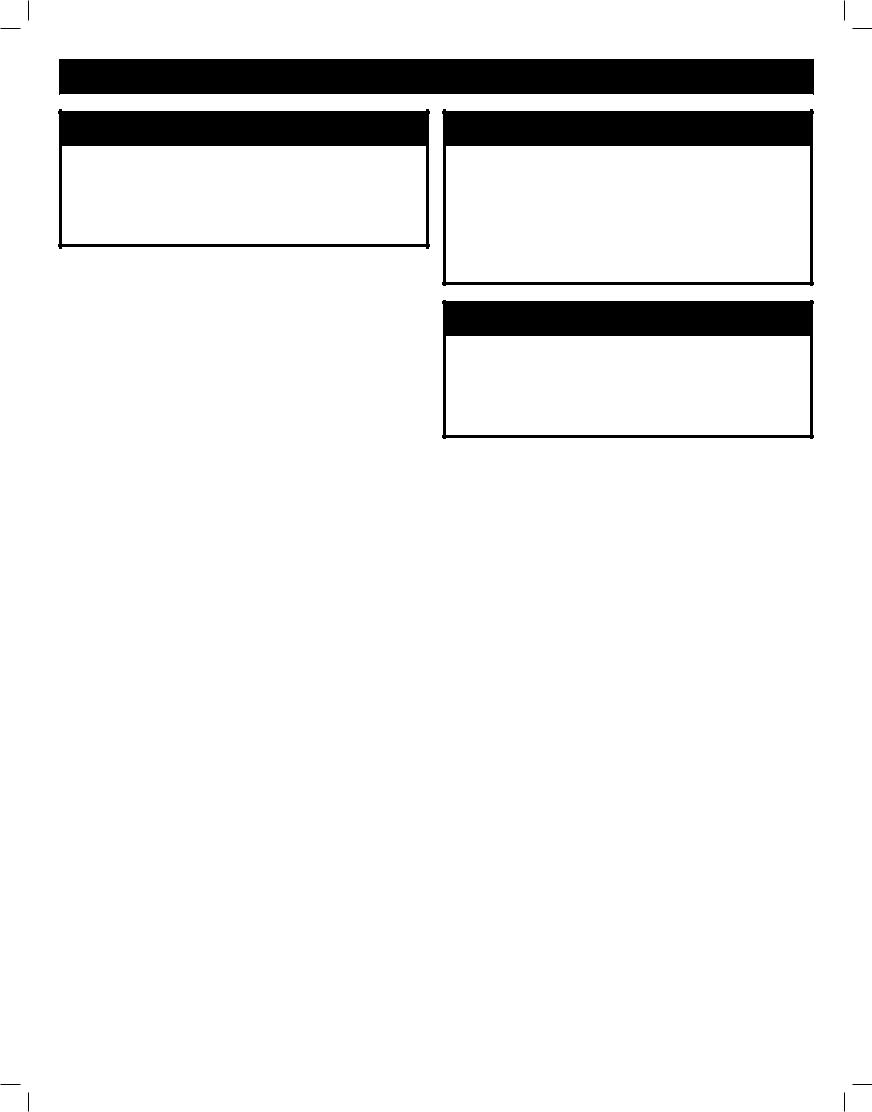
REFRIGERATOR INSTALLATION
 WARNING
WARNING
Excessive Weight Hazard:
Use two or more people to move and install the refrigerator. Failure to do so can result in back or other injury.
UNPACKING YOUR REFRIGERATOR
Remove tape and any temporary labels from your refrigerator before using. Do not remove any warningtype labels, the model and serial number label, or the Tech Sheet that is located under the front of the refrigerator, behind the base grille.
To remove any remaining tape or glue, rub the area briskly with your thumb. Tape or glue residue can also be easily removed by rubbing a small amount of liquid dish soap over the adhesive with your fingers. Wipe with warm water and dry.
Do not use sharp instruments, rubbing alcohol, flammable fluids, or abrasive cleaners to remove tape or glue. These products can damage the surface of your refrigerator.
Refrigerator shelves are installed in the shipping position. Please reinstall shelves according to your individual storage needs.
 WARNING
WARNING
Excessive Weight Hazard:
Your refrigerator is heavy. When moving the refrigerator for cleaning or service, be sure to protect the floor. Always pull the refrigerator straight out when moving it. Do not wiggle or walk the refrigerator when trying to move it, as floor damage could occur.
 WARNING
WARNING
Explosion Hazard:
Keep flammable materials and vapors, such as gasoline, away from the refrigerator. Failure to do so can result in fire, explosion, or death.
9

REFRIGERATOR INSTALLATION
PRIOR TO USE
1. Clean your refrigerator thoroughly and wipe all dust that accumulated during shipping.
2.Install accessories such as ice cube bin, drawers, shelves, etc., in their proper places. They are packed together to prevent possible damage during shipment.
3.Allow your refrigerator to run for at least two to three
hours before putting food in it. Check the of cold air in the freezer compartment to ensure proper cooling. Your refrigerator is now ready for use.
2” (5.08 cm) |
2” (5.08 cm) |
|
|
|
|
|
|
|
|
|
|
|
|
|
|
2” (5.08 |
cm) |
2” (5.08 |
cm) |
||||||||||
INSTALLATION
The refrigerator should always be plugged into its own individual properly grounded electrical outlet rated for 115 Volts, 60 Hz, AC only, and fused at 15 or 20 amperes. This provides the best performance and also prevents overloading house wiring circuits which could cause a hazard from overheated wires. It is recommended that a separate circuit serving only this appliance be provided. (See the LEVELING and DOOR ALIGNMENT sections.)
 WARNING
WARNING
Shock Hazard:
To reduce the risk of electric shock, do not install the refrigerator in a wet or damp area.
1. To avoid noise and vibration, the unit must be |
|
|
leveled and installed on a solidly constructed |
If |
|
required, adjust the leveling legs to compensate for |
|
|
unevenness of the |
The front should be slightly |
|
higher than the rear to aid in door closing. Leveling legs can be turned easily by tipping the cabinet
slightly. Turn the leveling legs clockwise to raise the unit or counterclockwise to lower it. (See LEVELING and DOOR ALIGNMENT sections.)
NOTE: Installing on carpeting, soft tile surfaces, a platform or weakly supported structure is not recommended.
2.Install this appliance in an area where the temperature is between 55°F (13°C) and 110°F (43°C). If the
temperature around the appliance is too low or high, cooling ability may be adversely
3.Select a place where a water supply can be easily connected for the automatic icemaker.
NOTE: The water pressure must be between 20 and
120 psi on models without a water |
and between |
40 and 120 psi on models with a water
4.Too small of a distance from adjacent items may result in lowered freezing capability and increased electricity consumption charges. Allow at least 24 inches (61 cm) in front of the refrigerator to open the doors.
5. If a |
is |
connected to your cold water supply, the water pressure to the reverse osmosis system needs to be a minimum of 40 to 60 psi (2.8 kgf/cm2 ~ 4.2 kgf/cm2, less than 2.0~3.0 sec. to a cup of 7 oz capacity).
a cup of 7 oz capacity).
Please refer to Connecting the Water Line section for more information on a reverse osmosis system.
10
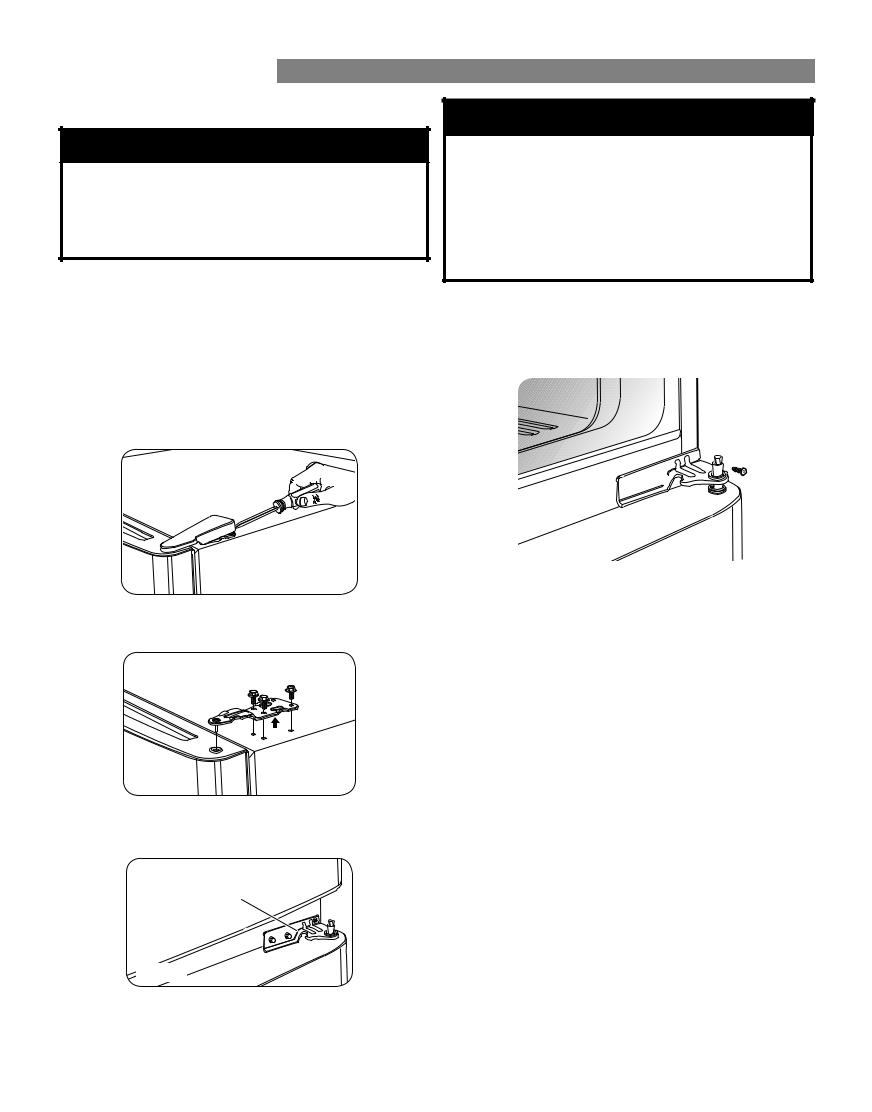
REMOVING AND REPLACING THE DOORS
 WARNING
WARNING
Excessive Weight Hazard:
Use two or more people to remove and install the refrigerator doors. Failure to do so can result in back or other injury.
TOOLS NEEDED
•10mm or 13/32 -inch socket wrench
•(with 2-inch extension for bottom door hinge)
•No. 2 Phillips head screwdriver
•Flat-head screwdriver for prying
•Adjustable wrench
REMOVING THE FREEZER DOOR
Remove the top-hinge cover by gently prying it with a  head screwdriver.
head screwdriver.
Using either a 10 mm or 13/32 in. socket wrench, remove the three bolts and lift the top hinge. Set parts aside.
the top hinge. Set parts aside.
Carefully lift up the freezer door. Place the door on a nonscratching surface.
Middle Hinge Bracket
Hinge Pin
REFRIGERATOR INSTALLATION
 WARNING
WARNING
Electrical Shock Hazard
•Disconnect the electrical supply to the refrigerator before installing. Failure to do so could result in serious injury or death.
•Do not put hands, feet or other objects into the air vents, base grille, or bottom of the refrigerator. You may be injured or receive an electrical shock.
REMOVING THE REFRIGERATOR DOOR
Loosen and remove the two bolts using a phillips head screwdriver.
Middle
Hinge Bracket
Remove the middle hinge bracket.
Carefully lift up the door. Place the door on a nonscratching surface.
11

REFRIGERATOR INSTALLATION
REPLACING THE REFRIGERATOR DOOR
Lower the door onto the bottom hinge pin.
Place the hinge pin of the middle hinge bracket inside of the hinge pin insert on top of the door. Hold the door in place and line the middle hinge bracket with the holes in the refrigerator housing.
Use the two bolts and phillips screwdriver to refasten the middle hinge bracket and door to the refrigerator housing.
REPLACING THE FREEZER DOOR
Set the freezer door onto the Middle Hinge pin.
Place the upper hinge pin in the top of the freezer door and line up the upper hinge with the holes on top of the refrigerator. Use the three bolts to replace the hinge.
Carefully force-fit the top hinge cover back into place over the hinge.
12

REVERSING THE DOORS
 WARNING
WARNING
ELECTRICAL SHOCK HAZARD
power at the circuit breaker or fuse box. Failure to do so could result in death or serious injury.
 CAUTION
CAUTION
Remove food and any Adjustable Shelves or Door Bins from doors. Failure to do so could result in serious injury.
TOOLS NEEDED
•10mm or 13/32 inch socket wrench (with 2-inch extension for bottom door hinge)
•No. 2 Phillips head screwdriver
•1/4 inch socket wrench
•Flat-head screwdriver for prying
•Adjustable wrench
•3/32 - inch hex wrench
REVERSING THE FREEZER DOOR
Remove the two screws located on the bottom part of the freezer handle with a screwdriver.
REFRIGERATOR INSTALLATION
Loosen the handle mounting fastener with a ¼” hex wrench.
Fastener
Unscrew the plug button with your |
by rotating it |
counterclockwise. |
|
Plug  button
button
Handle 
Screws
Loosen the upper set screw with a 3/32” hex wrench and remove the handle. The freezer handle is going to be the refrigerator handle when reversing the doors.
NOTE: Grasp the handle tightly so that it does not fall when the screws are removed.
Screw 
 Handle
Handle
Wrench
Install the plug button on the left side and the handle mounting fastener on the right side.
Plug
button 
Mounting
fastener
Gently pry  the top hinge cover with a
the top hinge cover with a  head screwdriver and remove.
head screwdriver and remove.
13

REFRIGERATOR INSTALLATION
Using 10mm or 13/32 inch socket wrench, remove the three bolts and lift off the top hinge. Set parts aside.
Top Hinge
Slightly lift up the refrigerator door and remove it.
 Middle Hinge Bracket
Middle Hinge Bracket
Hinge Pin
Turn the freezer door upside down on a non-scratch surface.
Loosen the screw to remove the Door Closer/Stop and
Hinge Pin Insert.
Door Closer / Stop
Pry off the cover on the top left side of the refrigerator to uncover the screw holes.
Set the freezer door and top hinge parts to the side and remove the refrigerator door.
Cover (on top of
refrigerator)
REVERSING THE REFRIGERATOR DOOR
Remove the Hinge Hole Plug and the two screws located in the upper part of refrigerator handle with a screwdriver.
Screws
Hinge Hole
Plug
Handle
Move the Hinge Pin Insert Bracket to the other side of the door, keeping the same orientation, and move the Hinge Pin Insert into the hole on the left side of the bracket.
Hinge Pin Insert
Hinge Pin
 Insert Bracket
Insert Bracket
Loosen the upper set screw with a 3/32” hex wrench and remove the handle. The refrigerator handle is going to be the freezer handle when reversing doors.
NOTE: Grasp the handle tightly so that it does not fall when the screws are removed.
Screw
Wrench
Handle
Reverse the Door Closer/Stop by flipping it over. Place it on top of the Hinge Pin Insert Bracket, and tighten both
down with the screw.
14
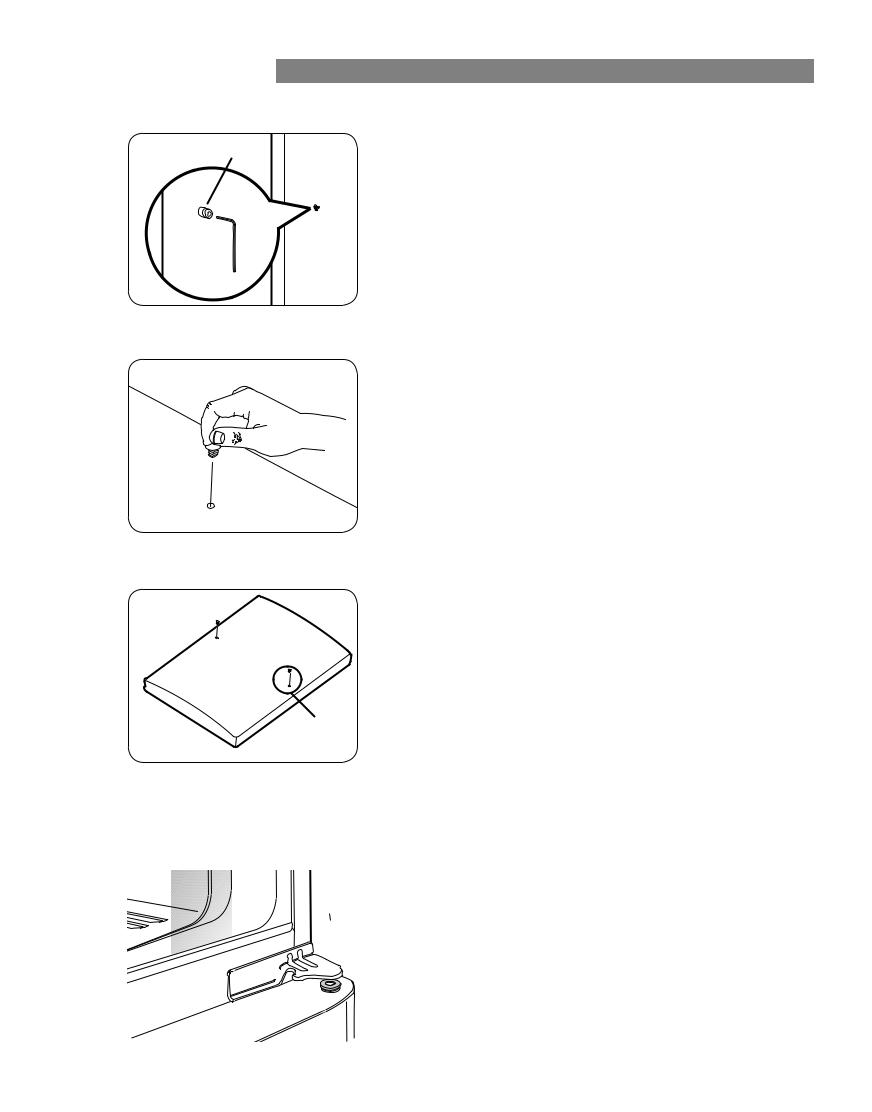
REFRIGERATOR INSTALLATION
Loosen the handle mounting fastener with a ¼” hex wrench.
Fastener
Unscrew the plug button with your fingers by rotating it counterclockwise; it will loosen and fall free.
Loosen and remove the two bolts and use the Phillips head screwdriver to remove the Middle Hinge Bracket from the refrigerator housing. Set parts aside.
Plug  button
button
Install the plug button on the left side and install the handle mounting fastener on the right side.
Plug
button 

Mounting
fastener
Using a ¼” socket wrench, loosen and remove Hinge Pin from the Middle Hinge Bracket. Remove washer underneath the middle hinge and set aside.
NOTE: At this point the door will be loose. Slightly lift the door and remove it.
Remove the washer from the Bottom Hinge Pin.
Using a ¼” socket wrench, loosen and remove the Hinge Pin from the Bottom Hinge. Reattach the Hinge Pin to the opposite side of the hinge.
NOTE: This is easier to do while the hinge is still attached.
15
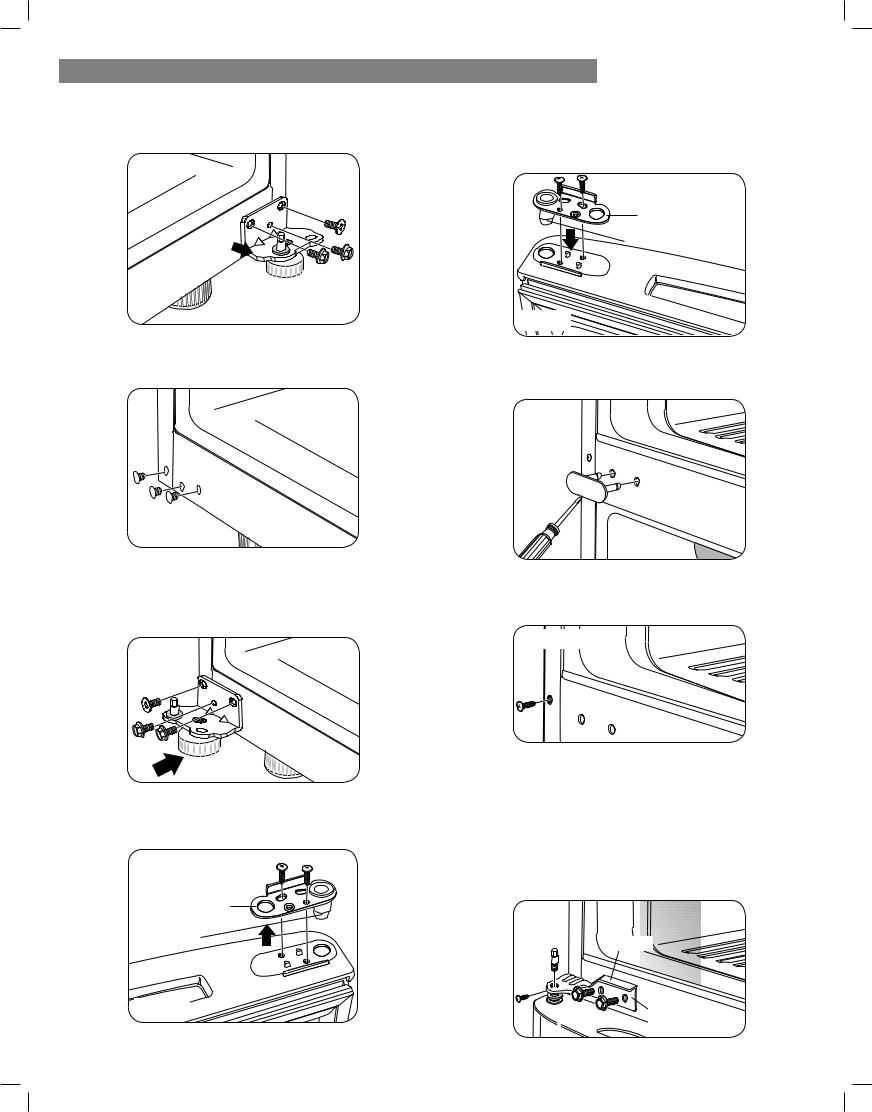
REFRIGERATOR INSTALLATION
Using a 13/32’’ socket wrench with a 2-Inch extension and screwdriver, loosen the two bolts and one screw, and remove the Bottom Hinge from right side of the housing.
Take out the Hinge Pin Insert and move the Bracket to the other side of the door, keeping the same orientation. Place the Hinge Pin Insert into the left side of the bracket. Tighten the Hinge Pin Bracket to the door.
Hinge |
Pin Bracket |
Hinge Pin Insert
Remove the Decorative Caps on the bottom of the refrigerator housing. You will need these holes for the Bottom Hinge.
Move the Bottom Hinge to the  left side of the housing, keeping the same orientation, and reattach with the two bolts and one screw. The flat screw must be placed on the exterior side of the hinge. Move the Decorative Bolt to the hole on the lower right side of the housing.
left side of the housing, keeping the same orientation, and reattach with the two bolts and one screw. The flat screw must be placed on the exterior side of the hinge. Move the Decorative Bolt to the hole on the lower right side of the housing.
Turn the refrigerator door upside down on a nonscratching surface. Loosen the two screws to remove the Bottom Hinge Pin Insert Bracket with the Hinge Pin Insert.
Hinge |
Pin Bracket |
Hinge Pin
Insert
With a flat-head screwdriver, carefully pry off and remove the cover over the screw holes on the left side of refrigerator housing.
Remove the outer lower Decorative Screw from the housing at the area between the freezer and refrigerator doors. (You will need this hole for the Middle Hinge Bracket.)
Flip the Middle Hinge Bracket, (flange will now be on top) position it on left side of the refrigerator and reattach with two bolts and a Phillips screwdriver. Place the refrigerator door down over the pin on the bottom hinge. Place the washer between the refrigerator door and middle hinge and re-attach Hinge Pin to Hinge Bracket with a ¼” socket wrench.
NOTE: Bracket has been flipped, but Hinge Pin stays in the same orientation with its hexagonal end facing upward.
Flange
Middle Hinge
Bracket
16

Insert the Decorative Screw into the outer hole on the right side of the housing. Attach cover on the right side. Cover is force-fitted.
Decorative
Screw
REATTACHING THE DOORS
Place the freezer door down over the Hinge Pin on the Middle Hinge Pin Bracket.
REFRIGERATOR INSTALLATION
Rotate the handles. The freezer handle will move to the refrigerator door, and the refrigerator handle will move to freezer door.
NOTE: Make sure that the handle screw holes are facing the right side of the door.
A
B 
Place the Upper Hinge Pin on top of the freezer door and line up the Upper Hinge with holes on top of the refrigerator. Use the three bolts to replace the Hinge.
Tighten the bolts. Force-fit Top Hinge Cover over Top
Hinge.
Replace cover on the top left side of the refrigerator to the right top to cover the holes. Cover is also force-fitted.
Cover (on top of refrigerator) 


B |
A 

Install the Freezer handle by adjusting the handle footprints to fit mounting fasteners. Tighten the set screws with a 3/32” hex wrench.
Handle  Screw
Screw
Wrench
Install the two screws under the handle with a screwdriver.

 Handle
Handle
Screws
17
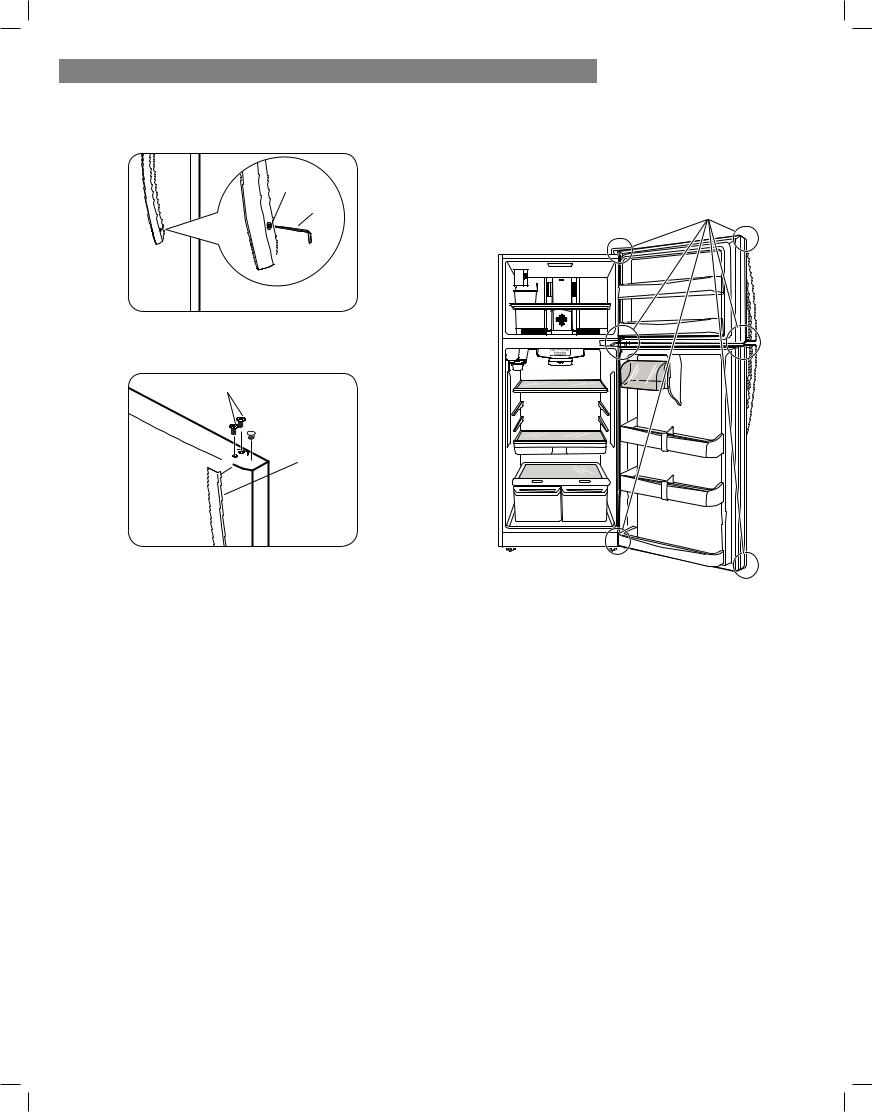
REFRIGERATOR INSTALLATION
Install the refrigerator handle by adjusting the handle footprints to fit the mounting fasteners. Tighten the set screws with a 3/32” hex wrench.
Screw
Wrench
 Handle
Handle
Install the Hinge Hole Pug and the two screws on the top of the handle with a screwdriver.
Screws
Hinge Hole
 Plug
Plug

 Handle
Handle
After switching the doors, make sure that the corners of the Door Gaskets are not folded over. To ensure a
good seal, apply a small amount of silicon grease on the corners of gaskets.
Corners
18

LEVELING
To avoid vibration, the unit must be leveled. If necessary, adjust the leveling legs to compensate for unevenness of the floor. The front should be slightly higher than the rear to aid in door closing.
Your refrigerator has two Front Leveling Screws - one on the right and one on the left. If your refrigerator seems unsteady or you want the doors to close more easily, adjust the refrigerator’s tilt using the instruction below:
1.Plug refrigerator power cord into a 3-prong grounded outlet. Move the refrigerator into its final position.
2.Insert a flat screwdriver in slots to adjust the Leveling
Screws. Turn the leveling screw clockwise to raise the side of the refrigerator or counterclockwise to lower it. It may take several turns of the leveling screw to adjust the tilt of the refrigerator.
NOTE: Having some push against the top of the refrigerator takes some weight off of the leveling screws.
This make it easier to adjust the screws.
3.Open both doors again and check to make sure that they close easily. If not, tilt the refrigerator slightly more to the rear by turning both leveling screws clockwise. It may take several more turns, and you should turn both leveling screws the same amount.
REFRIGERATOR INSTALLATION
DOOR ALIGNMENT
If the space between your doors is uneven, follow the instructions below to align the doors.
1.Gently pry off the refrigerator door Top Hinge Cover with a flat head screwdriver and remove. Loosen the
Top Hinge Bolts using a 10mm or 13/32’’ Socket wrench or open-end wrench.
2.Have a second person hold the refrigerator door in its proper position.
3.Replace the Top Hinge Cover.
19

USING YOUR REFRIGERATOR
SETTING THE CONTROLS
AIRFLOW
In order to ensure proper temperatures, air must  between the refrigerator and freezer sections. As shown in the illustration below, air enters at the top of the freezer and circulates down. Air enters through the top vent of the refrigerator, then circulates and exists at the bottom, where it returns to the freezer.
between the refrigerator and freezer sections. As shown in the illustration below, air enters at the top of the freezer and circulates down. Air enters through the top vent of the refrigerator, then circulates and exists at the bottom, where it returns to the freezer.
When loading your refrigerator, make sure that items do not block the air vents. Items that block air vents will restrict air 
TEMPERATURE
When changing control settings, wait 24 hours before making additional adjustments. The controls are set correctly when milk or juice is as cold as you would like and when ice cream is  If the temperature in either compartment is too cold or too warm, change the setting one increment at a time. Wait 24 hours for the change to stabilize before adjusting again.
If the temperature in either compartment is too cold or too warm, change the setting one increment at a time. Wait 24 hours for the change to stabilize before adjusting again.
TEMPERATURE ADJUST
Press the TEMPERATURE ADJUST button repeatedly to select one of the  temperature levels between COLD and COLDEST.
temperature levels between COLD and COLDEST.
WATER LOCK
Press the WATER LOCK button to lock the water dispenser.
The WATER LOCK button will illuminate when the Water Lock is activated. The water dispenser will not operate at this time.
To unlock the water dispenser, press the button WATER LOCK button again. The WATER LOCK button light will
FILTER CHANGE
When the water  indicator turns on, you have to change the water
indicator turns on, you have to change the water  After changing the water press and hold the FILTER CHANGE button for three
After changing the water press and hold the FILTER CHANGE button for three
seconds to turn the indicator light  You need to change the water
You need to change the water  approximately every six months.
approximately every six months.
FREEZER CONTROL
Turn the temperature dial up or down to adjust the temperature. Turn the dial up for a colder temperature or down for a warmer temperature.
Demo Mode (For Store Use Only)
Demo Mode disables all cooling in the refrigerator and freezer sections to conserve energy while on display in a retail store. When activated, OFF will display on the control panel.
COLD  COLDEST
COLDEST
COLD |
COLDEST |
To deactivate: |
|
Press the TEMPERATURE ADJUST button until your desired |
|||
|
|
||
|
|
temperature setting is reached. The OFF light will turn |
|
|
|
once the Demo Mode is deactivated. |
20

FOOD STORAGE GUIDE
Wrap or store food in the refrigerator in airtight and moisture-proof material unless otherwise noted. This prevents food odor and taste transfer throughout the refrigerator. For dated products, check date code to ensure freshness.
Items |
How to |
|
|
Butter or |
Keep opened butter in a covered |
margarine |
dish or closed compartment. |
|
When storing an extra supply, |
|
wrap in freezer packaging and |
|
freeze. |
|
|
Cheese |
Store in the original wrapping |
|
until you are ready to use it. Once |
|
opened, rewrap tightly in plastic |
|
wrap or aluminum foil. |
|
|
Milk |
Wipe milk cartons. For best |
|
storage, place milk on interior |
|
shelf. |
|
|
Eggs |
Store in original carton on interior |
|
shelf, not on door shelf. |
|
|
Fruit |
Wash, let dry, and store in |
|
refrigerator in plastic bags or in |
|
the crisper. Do not wash or hull |
|
fruit until you are ready to use it. |
|
Sort and keep fruit in its original |
|
container, in a crisper, or store in a |
|
completely closed paper bag on a |
|
refrigerator shelf. |
|
|
Leafy |
Remove store wrapping and trim |
vegetables |
or tear off bruised and discolored |
|
areas. Wash in cold water and |
|
drain. Place in plastic bag or |
|
plastic container and store in |
|
crisper. |
|
|
Vegetables |
Place in plastic bags or plastic |
with skins |
container and store in crisper. |
(carrots, |
|
peppers) |
|
|
|
Fish |
Use fresh fish and shellfish the |
|
same day purchased. |
|
|
Leftovers |
Cover leftovers with plastic wrap, |
|
aluminum foil, or plastic containers |
|
with tight lids. |
|
|
USING YOUR REFRIGERATOR
STORING FROZEN FOOD
NOTE: Check a freezer guide or a reliable cookbook for further information about preparing food for freezing or food storage times.
Freezing
Your freezer will not quick-freeze a large quantity of food. Do not put more unfrozen food into the freezer than will freeze within 24 hours (no more than 2 to 3 lbs. of food per cubic foot of freezer space). Leave enough space in the freezer for air to circulate around packages. Be careful to leave enough room at the front so the door can close tightly.
Storage times will vary according to the quality and type of food, the type of packaging or wrap used
(how airtight and moisture-proof) and the storage temperature. Ice crystals inside a sealed package are normal. This simply means that moisture in the food and air inside the package have condensed, creating ice crystals.
NOTE: Allow hot foods to cool at room temperature for 30 minutes, then package and freeze. Cooling hot
foods before freezing saves energy.
Packaging
Successful freezing depends on correct packaging. When you close and seal the package, it must not allow air or moisture in or out. If it does, you could have food odor and taste transfer throughout the refrigerator and could also dry out frozen food.
Packaging recommendations:
•Rigid plastic containers with tight-fitting lids
•Straight-sided canning/freezing jars
•Heavy-duty aluminum foil
•Plastic-coated paper
•Non-permeable plastic wraps
•Specified freezer-grade self-sealing plastic bags
Follow package or container instructions for proper freezing methods.
Do not use
•Bread wrappers
•Non-polyethylene plastic containers
•Containers without tight lids
•Wax paper or wax-coated freezer wrap
•Thin, semi-permeable wrap
 CAUTION: Do not keep beverage cans or plastic food containers in the freezer compartment. They may break or burst if they freeze.
CAUTION: Do not keep beverage cans or plastic food containers in the freezer compartment. They may break or burst if they freeze.
21
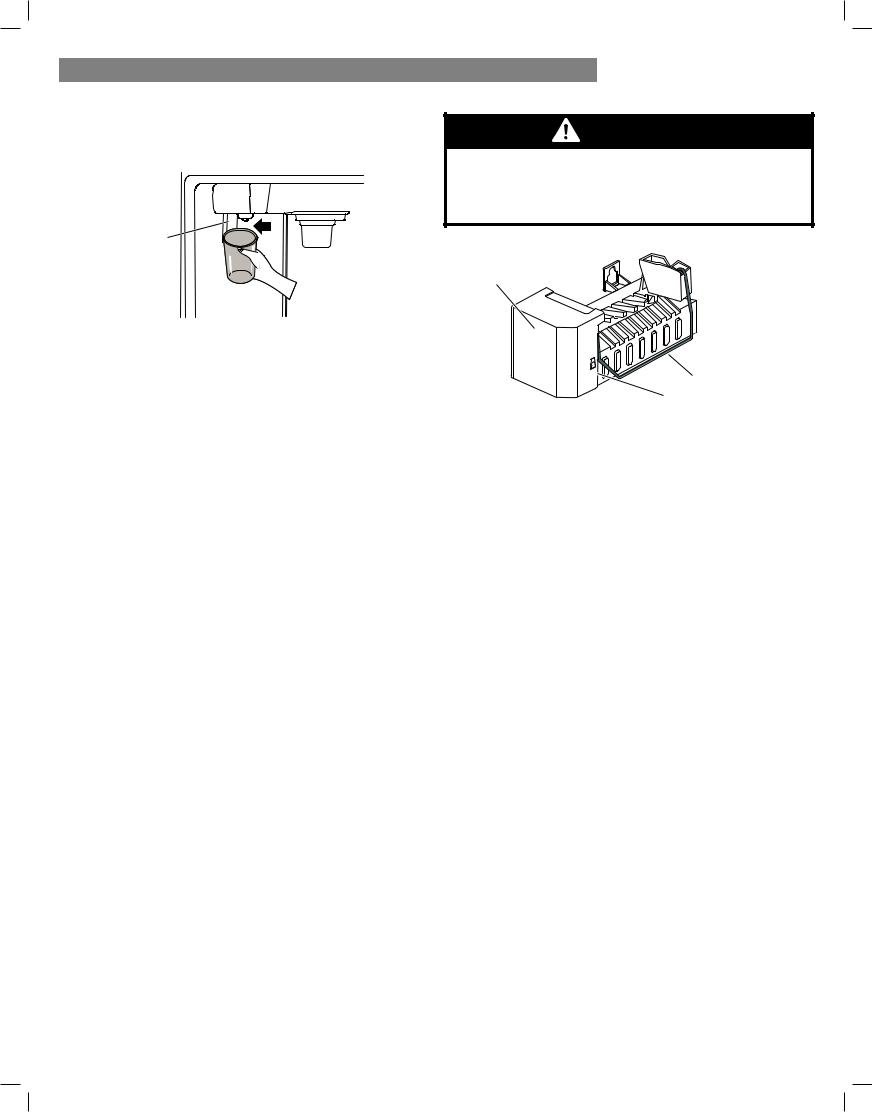
USING YOUR REFRIGERATOR
WATER DISPENSER
To dispense cold water, push on the dispenser switch with a glass.
Dispenser
Switch
Some dripping may occur after dispensing. Hold your cup beneath the dispenser for a few seconds after dispensing to catch all of the drops.
 WARNING: Do not put your fingers up the ice chute opening. Doing so can result in severe injury.
WARNING: Do not put your fingers up the ice chute opening. Doing so can result in severe injury.
 CAUTION: Do not dispense ice into fine china or crystal glasses. China or crystal can break.
CAUTION: Do not dispense ice into fine china or crystal glasses. China or crystal can break.
AUTOMATIC ICEMAKER (on some models)
The icemaker will produce approximately 100-130 cubes in a 24-hour period, depending on freezer compartment temperature, room temperature, number of door openings and other operating conditions.
•It takes about 12 to 24 hours for a newly installed refrigerator to begin making ice. Wait 72 hours for full ice production to occur.
•Ice making stops when the bin fills to the lever of the feeler arm.
•To turn off the automatic icemaker, set the icemaker switch to OFF (O). To turn on the automatic icemaker, set the switch to ON (I).
•The water pressure must be between 20 and
120 psi on models without a water filter and between 40 and 120 psi on models with a water filter to produce the normal amount and size of
ice cubes.
 CAUTION
CAUTION
•Throw away the first few batches of ice (about 24 cubes). This is also necessary if the refrigerator has not been used for a long time.
•Never store beverage cans or other items in the ice bin for the purpose of rapid cooling. Doing so may damage the icemaker or the containers may burst.
•Never use thin crystal glass or crockery to collect ice. Such containers may chip or break resulting in glass fragments in the ice.
WARNING
Personal Injury Hazard
DO NOT place fingers or hands on the automatic ice making mechanism while the refrigerator is plugged in.
Icemaker
Ice detecting sensor
Power Switch
WHEN YOU SHOULD SET THE ICEMAKER
POWER SWITCH TO OFF (O)
•When the water supply will be shut off for several hours.
•When the ice bin is removed for more than one or two minutes.
•When the refrigerator will not be used for several days.
NOTE: The ice bin should be emptied when the icemaker ON/OFF switch is turned to the OFF position.
NORMAL SOUNDS YOU MAY HEAR
•The icemaker water valve will buzz as the icemaker fills with water. If the power switch is in the ON (I) position, it will buzz even if it has not yet been hooked up to water. To stop the buzzing, move the power switch to
OFF (O).
NOTE: Keeping the power switch in the ON (I) position before the water line is connected can damage the icemaker.
•You will hear the sound of cubes dropping into the bin and water running in the pipes as the icemaker refills.
PREPARING FOR VACATION
Set the icemaker power switch to OFF (O) and shut off the water supply to the refrigerator.
NOTE: The ice bin should be emptied anytime the icemaker ON/OFF switch is turned to the OFF (O) position.
If the ambient temperature will drop below freezing, have a qualified technician drain the water supply system to prevent serious property damage due to flooding caused by ruptured water lines or connections.
22

USING YOUR REFRIGERATOR
REFRIGERATOR SHELVES
The glass shelves in your refrigerator are adjustable to meet your individual storage needs.
Adjusting the shelves to fit different heights of items will make finding the exact item you want easier. Doing so will also reduce the amount of time the refrigerator door is open which will save energy.
IMPORTANT: Do not clean glass shelves with warm water while they are cold. Shelves may break if exposed to sudden temperature changes or impact.
NOTE: Glass shelves are heavy. Use special care when removing them.
Adjusting Shelves
Remove shelves from the shipping position and replace shelves in the position you want.
To remove a shelf—Tilt up the front of the shelf in the direction of 1 and lift it in the direction of 2 . Pull the shelf out.
1 |
2 |
PANTRY DRAWER (on some models) To remove the Pantry Drawer:
Remove the door bins 1 before removing or replacing the pantry drawer 2 .
2 |
1 |
|
Grasp the drawer handle and pull it forward to the drawer stop. Lift up and pull out.
To reinstall a shelf—Slide the shelf into the guides until it stops.
To replace the Pantry Drawer:
Slide the drawer back all the way past the drawer stop.
23
